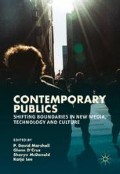Abstract
The singularity of the concepts of public and public sphere is explored in this essay and ultimately challenged. Through an investigation of the deployment of the term public, a determination of the relationship of the private to the public, and a study of the emergence and value of the term “publics,” the book’s sections and contributions are introduced.
Access this chapter
Tax calculation will be finalised at checkout
Purchases are for personal use only
Bibliography
Anderson, Benedict. 1983. Imagined communities. London: Verso.
Arnold, Matthew, and Jane Garnett. 2009 (1869). Culture and anarchy. Reissued. ed, Oxford world’s classics. Oxford: Oxford University Press.
Bernays, Edward L. 2015 (1923). Crystallizing public opinion. Newburyport: Open Road Media.
——— 1947. The engineering of consent. Annals of Social and Political Science250(1): 113–120.
boyd, danah. 2010. Social network sites as networked publics. In A networked self, ed. Zizi Papacharissi, 38–59. New York: Routledge.
Bruns, Axel, and Hallvard Moe. 2014. The structural forms of communications on Twitter. In Twitter and society, eds. Katrin Weller, Axel Bruns, Jean Burgess, Merja Mahrt, and Cornelius Puschmann, 16–27. New York: Peter Lang.
Busby, Robert. 2001. Defending the American presidency: Clinton and the Lewinsky scandal: Houndmills, Basingstoke, Hampshire. New York: Palgrave.
Cutlip, Scott M. 1994. The unseen power: Public relations, a history, LEA’s communication series. Hillsdale: Erlbaum Associates.
Emirbayer, Mustafa, and Mimi Sheller. 1999. Publics in history. Theory and Society 28: 145–197.
Fraser, N. 1992. Rethinking the public sphere. In Habermas and the public sphere, ed. C. Calhoun, 109–142. Cambridge, MA/London: MIT Press.
Gripsrud, Jostein, and Hallvard Moe. 2010. The digital public sphere: Challenges for media policy. Goẗeborg: Nordicom.
Habermas, Jürgen. 1989. The structural transformation of the public sphere: An inquiry into a category of bourgeois society, studies in contemporary German social thought. Cambridge, MA: MIT Press.
Livingstone, Sonia M. 2005. Audiences and publics: When cultural engagement matters for the public sphere. Changing media–changing Europe series, vol. 2. Bristol/Portland: Intellect.
Marshall, P. David. 2015. Intercommunication and persona: Intercommunicative public self. International Journal of Interdisciplinary Studies in Communication 10(1): 23–31.
Papacharissi, Zizi A. 2010. A private sphere: Democracy in a digital age, DMS—Digital Media and Society. Hoboken: Wiley.
Roberts, John Michael. 2014. Digital publics: Cultural political economy, financialization and creative organizational politics. New York: Routledge.
Rojek, Chris. 2001. Celebrity. London: Reaktion.
Schmidt, Jan-Hinrik. 2014. Twitter and the rise of the personal publics. In Twitter and society, eds. Katrin Weller, Axel Bruns, Jean Burgess, Merja Mahrt, and Cornelius Puschmann, 3–14. New York: Peter Lang.
Spigel, Lynn. 2001. Welcome to the dreamhouse: Popular media and postwar suburbs, console-ing passions. Durham: Duke University Press.
Warner, Michael. 2005. Publics and counterpublics. New York/London: Zone Books/MIT Press.
Williams, Linda, ed. 2004. Porn studies. Durham: Duke University Press.
Author information
Authors and Affiliations
Editor information
Editors and Affiliations
Copyright information
© 2016 The Author(s)
About this chapter
Cite this chapter
Marshall, P.D. (2016). Introduction: The Plurality of Publics. In: Marshall, P., D'Cruz, G., McDonald, S., Lee, K. (eds) Contemporary Publics. Palgrave Macmillan, London. https://doi.org/10.1057/978-1-137-53324-1_1
Download citation
DOI: https://doi.org/10.1057/978-1-137-53324-1_1
Published:
Publisher Name: Palgrave Macmillan, London
Print ISBN: 978-1-137-53323-4
Online ISBN: 978-1-137-53324-1
eBook Packages: Literature, Cultural and Media StudiesLiterature, Cultural and Media Studies (R0)

